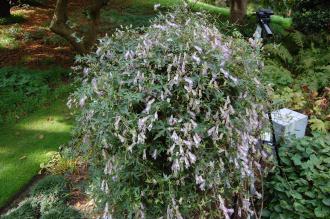
Aconitum episcopale (28/09/2014, Kew Gardens, London)
Position: Full sun to partial shade
Flowering period: Late summer to early autumn
Soil: Moist, well drained
Eventual Height: 4m
Eventual Spread: 2m
Hardiness: 6a, 6b, 7a, 7b, 8a, 8b, 9a, 9b
Family: Ranunculaceae
Aconitum episcopale is a deciduous, herbaceous perennial with a scrambling/ climbing habit. Its dark green leaves are ovate-pentagonal, deeply lobed with up to 5 segments and up to 7cm long and 10cm across. Its stems are twining which enables this plan to climb. Its pale blue flowers are hood shaped, up to 25mm.

Aconitum episcopale Flower (28/09/2014, Kew Gardens, London)
Aconitum episcopale, commonly known as Climbing Monkshood, is native to south central China. In its native habitat it grows at woodland margins and grassy slopes. All parts of this plant are extremely toxic.
The etymological root of the binomial name Aconitum is from the ancient Greek name for this plant and is loosely translated as ‘unconquerable poison’. We are unclear of the derivation of Episcopale, reader feedback would be welcome.
The landscape architect may find Aconitum episcopale useful as a climbing plant with pale blue flowers in early autumn. Care should be taken when locating this plant due to its poisonous nature, including via skin.

Aconitum episcopale Leaf (28/09/2014, Kew Gardens, London)
Ecologically, Aconitum episcopale flowers are attractive to pollinating insects.
Aconitum episcopale prefers moist, fertile, well-drained soils. It tolerates most pH of soil. It dislikes wet soils.
Aconitum episcopale requires little maintenance. To keep a tidy appearance old flowering stems may be removed in spring. Large clumps may be divided in late autumn to late winter.

